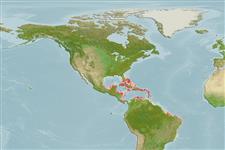>
Gobiesociformes (Clingfishes) >
Gobiesocidae (Clingfishes and singleslits) > Gobiesocinae
Etymology: Acyrtus: Greek, a = without + Greek, kyrtos, -e, -on = bent + Greek, ops = shape (Ref. 45335).
More on author: Poey.
Environment: milieu / climate zone / গভীরতার পরিসীমা / distribution range
বাস্তুসংস্থান
সামুদ্রিক সমুদতলে ভাসমান বেনথোপেলাজিক; গভীরতার পরিসীমা 0 - 4 m (Ref. 26938). Tropical
Western Atlantic: Bahamas and the Greater and Lesser Antilles. Grand Cayman, Isla de Providencia, western Caribbean from Mexico to Honduras (Ref. 26938).
আকৃতি / ওজন / Age
পরিপক্কতা : Lm ? range ? - ? cm
Max length : 3.5 cm TL পুরুষ/ লিঙ্গ অনিধর্ারিত ; (Ref. 5521)
Short description
সনাক্তকারী নির্দেশক | বহিঃ অঙ্গ সংস্থান | মরফোমেট্রিক্স
Upper lip widest at middle; no papillae in central part of disk (Ref. 26938).
Body shape (shape guide): elongated.
Lives in close association with the sea urchin Echinometra mainly for protection. Feeds primarily on benthic crustaceans like amphipods, but harpacticoid copepods and ostracods are also eaten (Ref. 33548).
Life cycle and mating behavior
পরিপক্কতা | প্রজনন | ডিম ছাড়া | ডিমসমূহ | ডিম্বধারন ক্ষমতা | শুককীট
Böhlke, J.E. and C.C.G. Chaplin, 1993. Fishes of the Bahamas and adjacent tropical waters. 2nd edition. University of Texas Press, Austin. (Ref. 5521)
IUCN Red List Status (Ref. 130435: Version 2025-1)
Threat to humans
Harmless
Human uses
মৎস্য: আকর্ষণবিহীণ
হাতিয়ার
Special reports
Download XML
ইন্টারনেট সুত্র
Estimates based on models
Preferred temperature (সূত্র
123201): 26.4 - 28.2, mean 27.5 °C (based on 497 cells).
Phylogenetic diversity index (সূত্র
82804): PD
50 = 0.5312 [Uniqueness, from 0.5 = low to 2.0 = high].
Bayesian length-weight: a=0.00617 (0.00250 - 0.01521), b=3.15 (2.94 - 3.36), in cm total length, based on LWR estimates for this (Sub)family-body shape (Ref.
93245).
ট্রফিক পর্যায়ে (সূত্র
69278): 3.3 ±0.45 se; based on food items.
স্থিতিস্থাপক (সূত্র
120179): উচ্চ, সর্বনিম্ন প্রজন দ্বিগুনের সময় ১৫ মাস (Preliminary K or Fecundity.).
Fishing Vulnerability (Ref.
59153): Low vulnerability (10 of 100).
🛈
Nutrients (Ref.
124155): Calcium = 712 [351, 1,719] mg/100g; Iron = 1.74 [0.89, 3.50] mg/100g; Protein = 16.7 [15.5, 18.0] %; Omega3 = 0.19 [0.08, 0.43] g/100g; Selenium = 19.2 [7.3, 56.3] μg/100g; VitaminA = 94 [24, 344] μg/100g; Zinc = 2.85 [1.79, 4.42] mg/100g (wet weight);
